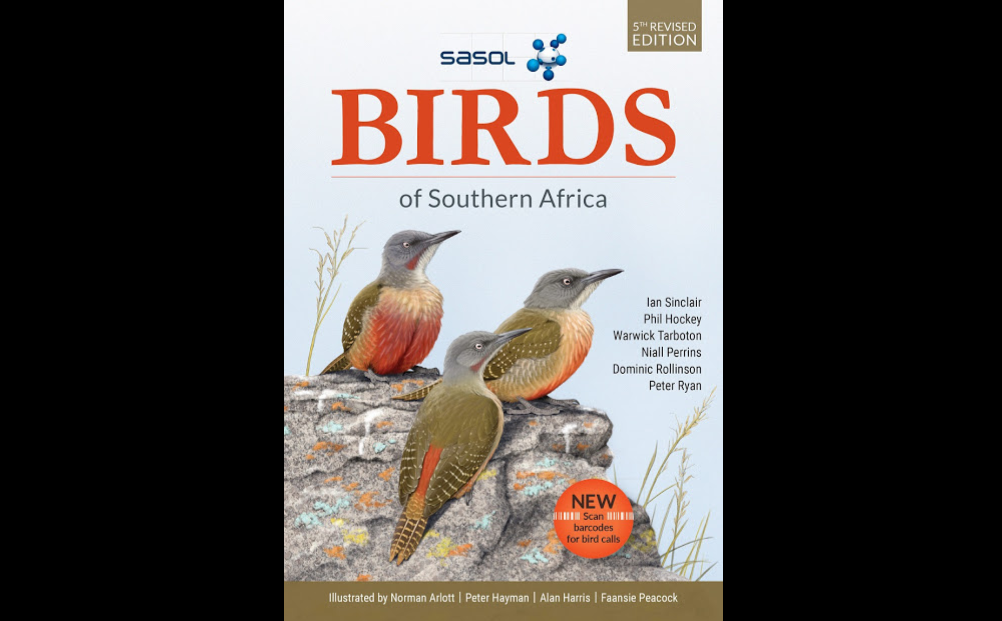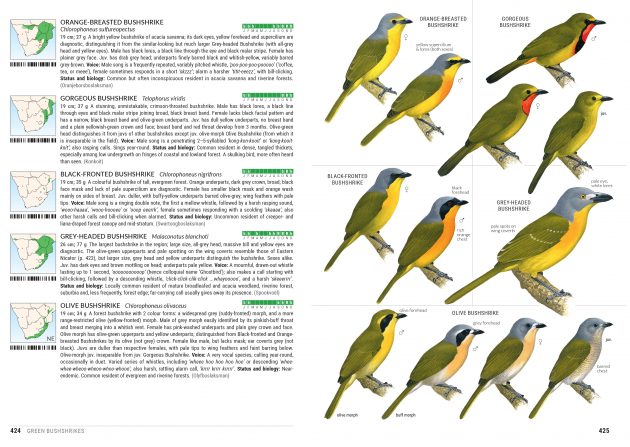
For several years I lived and birded in the south of Africa, and still have my battered second edition (1997) of the Sasol Birds of Southern Africa, the most trusted local field guide. Now, I am holding the 5th edition (2020) in my hands – what has changed in the meantime, especially in the 9 years since the 4th edition?
Before that, while you all know what South Africa is, what exactly is Southern Africa? There are several definitions of the wider southern African region, but the one accepted within the region and by the authors of this guide is that Southern Africa represents that part of the continent laying south of the Kunene and Zambezi rivers. Yet, unless you live in the region, you are likely to have a vague idea where the Zambezi flows and no idea where Kunene is. And so, back to political entities, this field guide covers Namibia, Botswana, Zimbabwe, the southern half of Mozambique (south of the Zambezi River), South Africa, Lesotho and Eswatini (Swaziland).
With 500 pages, this guide is a bit on the heavy side, but still not too much, having in mind that half of the region falls into the tropics and the edition is dealing with almost a thousand species (989 to be exact).
The inner side of the front cover contains the visual Quick Reference with paintings of one representative of the family followed by the relevant page number. The next page contains an alphabetical Quick Reference. The usual introductory chapters occupy less than 20 pages, describing the region and major biomes, conservation concerns (7 species are critically endangered, 28 endangered, 32 vulnerable and 52 near threatened), classification and nomenclature, recommended literature, bird clubs, endemics (96 regional and further 78 near-endemics, plus 2 families endemic to Southern Africa, the rockjumpers and sugarbirds) and glossary of terms. Sasol has largely retained the traditional ordering system, familiar to the majority of birders. The book ends with three indexes, of scientific, English and Afrikaans names.

Distribution maps show the relative abundance of a species in the region and also indicate resident or visiting status. With ongoing atlassing projects, the maps were surprisingly accurate even in the previous editions – to someone coming from Europe, at least, and in the 5th edition they are further updated. Actually, it is much easier to present bird distributions in the south of Africa than in e.g. Europe, where migratory routes further complicate the maps because the bird can appear everywhere, while at this far end of Africa it is either resident or visiting, not migrating. This region is so far from the northern breeding grounds that there are no migratory corridors to show.

Fully revised textual descriptions with fresh input from new contributing authors cover the usual, size, plumages, voice, conservation status, habitat and brief biology (e.g. association with other species and similar). After four editions, these descriptions are chiselled into almost perfection. The font is simple and well-chosen, though the font size tends to be on the smallish side. Next to the text is a seasonality bar showing not only in which months the species can be seen, but also when it is common (vs. uncommon), as well as when it breeds in the region. Another novelty is a barcode to be scanned with the free Struik Nature Call app, which will bring up the calls of that species (usually multiple calls) – if you have a phone signal when in the bush.
The artwork was of very high standards before and has only improved in this edition, with labels pinpointing key differentiating features. Especially the newly designed plates are meticulously realistic. The paintings are relatively large (=easy to use without reading glasses), and well-spaced. Perhaps birds of prey are somewhat overcrowded, but still well organised. Some plates are replaced entirely, e.g. the excellent seabirds, newly painted by Faansie Peacock (a name to remember). I particularly like the albatrosses and owls, shrikes and boubous. Beside the paperback, the Sasol app has also been updated in 2020 and is a massive improvement on the previous edition. The app has all the descriptions, maps, paintings and seasonality bars like the printed edition. Checking the boxes next to a bird’s name on the opening screen you can chose which two species to compare in the same screen. The additions are several photos per species (in total, over 2700 photos) and multiple calls for most species (more than 1000 calls). You can zoom right into the photos, illustrations and maps, to enlarge the details. The calls are sorted by type (song, alarm, etc.) and having them in your pocket makes a huge difference in your birding experience.
Beside the paperback, the Sasol app has also been updated in 2020 and is a massive improvement on the previous edition. The app has all the descriptions, maps, paintings and seasonality bars like the printed edition. Checking the boxes next to a bird’s name on the opening screen you can chose which two species to compare in the same screen. The additions are several photos per species (in total, over 2700 photos) and multiple calls for most species (more than 1000 calls). You can zoom right into the photos, illustrations and maps, to enlarge the details. The calls are sorted by type (song, alarm, etc.) and having them in your pocket makes a huge difference in your birding experience.
In the upper right corner of every species entry is a pencil. Clicking on it leads you to a life-list entry page, offering you to enter the date, location, coordinates – but not the number of individuals. The life-list offers a possibility of creating separate lists for various trips, search within the list and to sort the list by date or alphabetically.
The first author, Ian Sinclair, is one of Africa’s foremost field birders and has authored or co-authored over 20 bird books. Phil Hockey (1956–2013), former Director of the Fitz Institute at UCT, was a recognised authority on the biology of southern African birds. Warwick Tarboton is a well-known bird expert and writer who has produced a number of well-received books. Peter Ryan is Director of the Fitz Institute at UCT and has authored several books on the region’s birds. Niall Perrins is a dedicated birder, photographer and bird guide. Dominic Rollinson holds a PhD in seabird conservation and works as a bird guide.
New artwork has been supplied by long-standing contributor Norman Arlott, an accomplished British bird artist. New contributions from two other highly skilled artists too: Alan Harris, based in the UK, (all new raptor illustrations), and Faansie Peacock, based in South Africa and recognised through the region for his birding and artistic expertise (all new seabirds and nightjar illustrations).
First published in 1993, Sasol was soon recognized as more ambitious among the local field guides, the one that attracted nature lovers seriously devoted to birding. I need not recommend it to local birders – those already using Sasol will certainly buy the new edition and others will be tempted to follow the trait (the book sells itself, as one of the authors confidently told me). It is the overseas visitors who are unsure which field guide to choose – with Sasol Birds of Southern Africa you cannot go wrong.
The next question is, paperback or app? If you are a local birder, I would recommend both, a book to keep inside your car and an app to have in your shirt pocket. But what about visitors? My personal preference is the paper book and I am ready to carry it. But if you are coming on an organised tour (at least three of the top-ten birding tours in the world started in South Africa, one of them now based in the US), you can count on your guide to carry the paperback and you can travel lightweight with an app.
Sasol Birds of Southern Africa
Imprint: Struik Nature (Penguin Random House)
Country of origin: South Africa
Release date: June 2020
Authors: Ian Sinclair, Phil Hockey, Warwick Tarboton, Niall Perrins, Dominic Rollison, Peter Ryan
Illustrations: Norman Arlott, Peter Hayman, Alan Harris, Faansie Peacock
Dimensions: 210 x 148 x 30mm (L x W x T)
Format: Paperback
Pages: 504
Edition: 5th Revised Edition
ISBN-13: 978-1-77584-668-0











I saw one of the Bushshrikes from the plate page you included just a few days ago (though in a different geographic area.) I had a hard time identifying it because it’s underparts had not fully developed their rich yellow color yet. I could have used this post last week! 😉